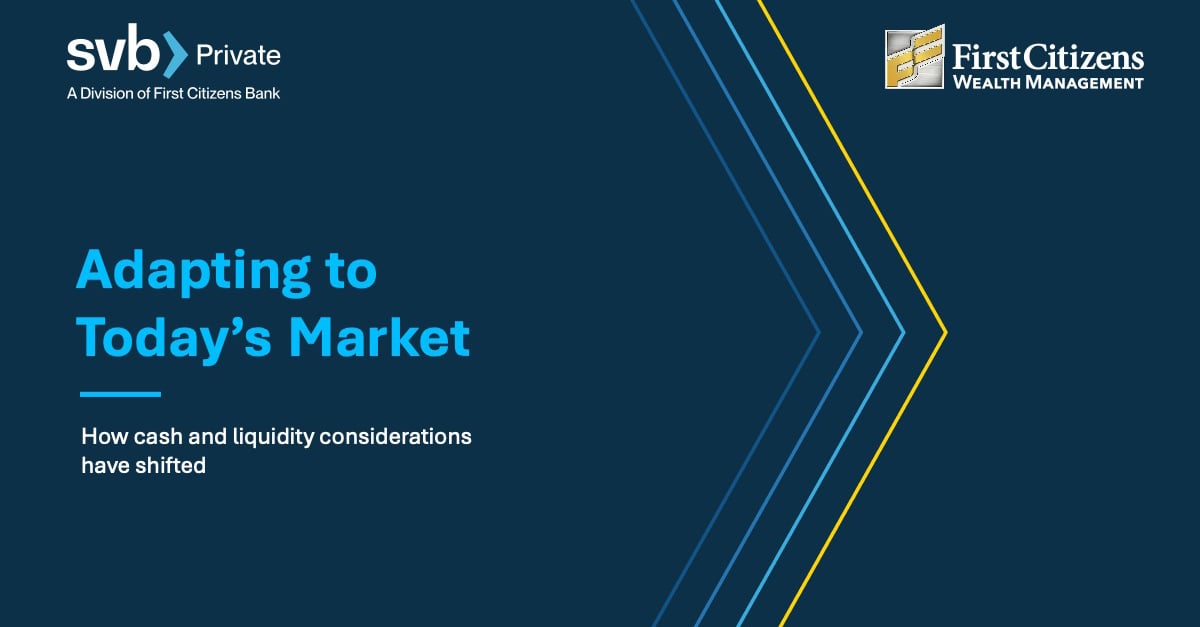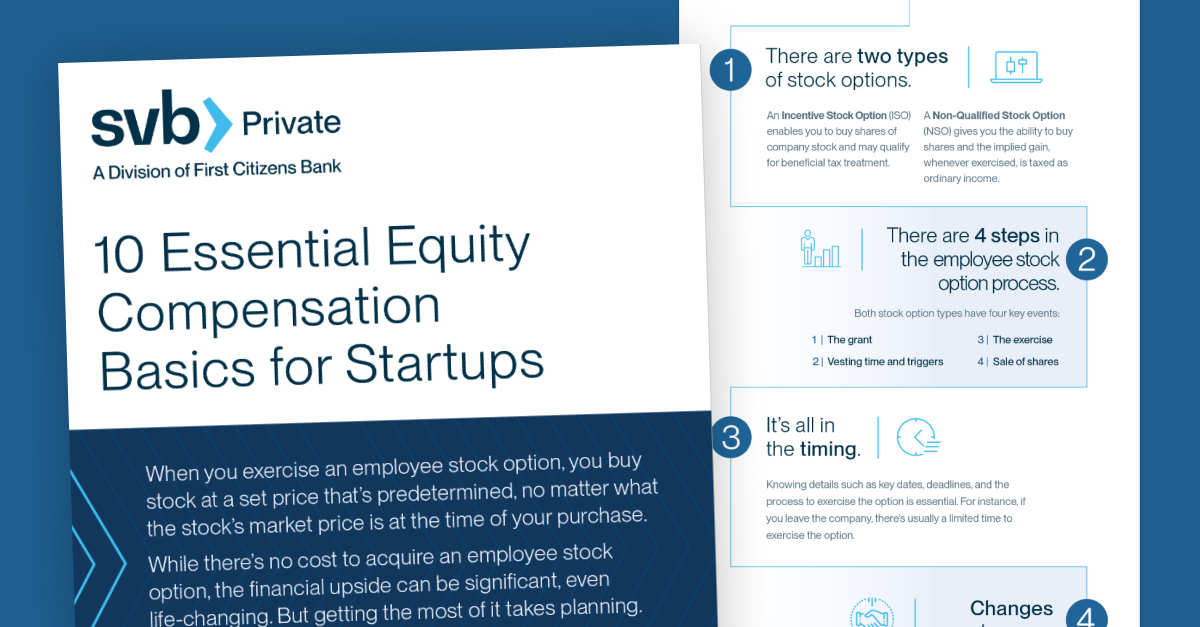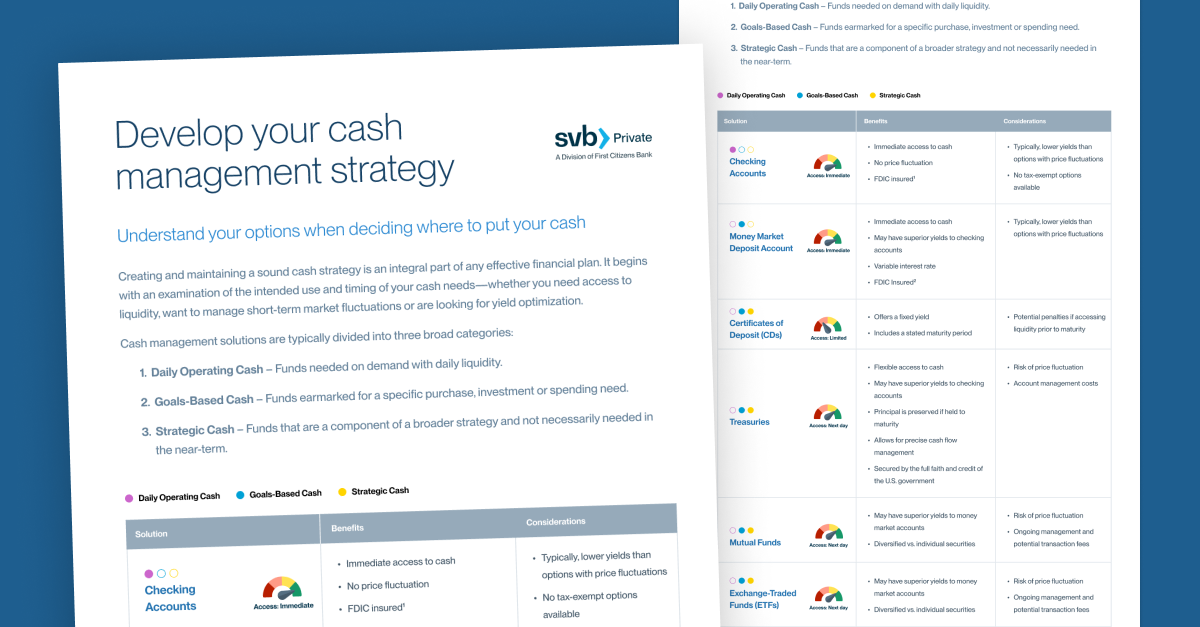Key takeaways
-
An effective cash management strategy involves a combination of traditional banking, investment solutions and requires attention to taxation.
-
Thorough liquidity planning addresses the funding of three categories based on needs: daily operating cash, goals-based funds and strategic positioning.
- Rising interest rates have increased the returns expected on cash and equivalents; however, investors should consider after-tax returns when making cash management decisions.
Ryan Fox: Hello everyone, and thank you for joining me today for this presentation about cash and liquidity options. I'm glad to have the opportunity to share some information about how you can determine the most valuable options for handling your cash assets. My hope is that you'll find it beneficial enough to make some timely decisions in the coming weeks and months.
So, getting started. Here's a quick look at our agenda today. I want to take you through our four subject areas. My hope is that by the end, you'll have a solid grasp on the choices you can make to manage your financial assets. First, I want to take you through liquidity concentrations. Here I'll talk about how we think about cash and liquidity and how it can fit into the broader framework of your financial planning.
Then I'll look at banking solutions. Most people are familiar with these, but there are a few that are less well known that I want to show you. After that, I'll talk about investment solutions. There are lots of strategies that aren't as well-known but are staples found in many portfolios. The events of earlier this year combined with the unique rates market that we're in now makes investment solutions all the more timely to discuss. Lastly, I'll cover rates. Here I'll go into details around today's rates as well as considerations every client should take into account when thinking about optimizing for taxes.
So, let's kick it off with liquidity considerations. The first category is daily operating. This is where your liquidity needs to be high so that you have access to the funds you need for essentials like mortgage payments, groceries, gas–just the regular daily stuff. So, liquidity is paramount here. The second is goals-based. These are the funds needed for something specific like a down payment on the home that you're going to acquire in several months or even years. Liquidity here is moderate.
The third is strategic. This is where liquidity can be a bit lower. These are funds that aren't necessarily needed in the near term but are still quite important. You might, for example, allocate funds to bonds in a portfolio to diversify your assets or to provide an income stream. Historically, the lowest yields are found in the daily operating category where the risk is lowest and the highest yields are in the strategic category where the risk is highest. It's worth pointing out that if you have more than $250,000 in a checking account for operating cash, you probably should reconsider whether you need that amount. And in terms of liquidity perspective, virtually everything that I'm discussing today can be converted to cash in a checking account within one or two business days.
Now to the pros and cons of different liquidity management solutions, you're probably familiar with many of these options, whether it's a bank account, certificates of deposit or a mutual fund. The important point here is that while all of them have some benefits, in some cases there may also be drawbacks. Bank accounts, which almost everyone certainly has, tend to be a necessity, but you also tend to get lower yields and are generally not very tax-efficient. On the other hand, certificates of deposits or CDs have historically had higher yields, but also tend to have penalties if you want to access liquidity prior to maturity. Each of these solutions serves a purpose and more often than not, deploying multiple solutions will help you meet your financial needs more effectively.
Let's move on to banking solutions. I'm sure everyone's familiar with these, but here's just a quick overview of the three main types of bank accounts. The deposit accounts, like traditional checking accounts, these each come with that $250,000 FDIC coverage. NOW accounts, they can have higher yields, but they do come with potential penalties for early liquidity. Finally, Insured Cash Sweep, or ICS, this is a banking solution that enables you to seamlessly insure funds by placing deposits through one SVB account into multiple institutions each with a $250,000 FDIC insurance coverage limit. And what this does is allows you to achieve insurance coverage above $100 million. This was a lesser-known option for this year, and it's important to point out that this is also available for individuals.
To give a little bit more detail, ICS is a convenient and simple way to protect the deposit. With ICS, you deposit funds to multiple accounts with FDIC protection. Your funds are sent from your SVB account to deposit accounts at other ICS institutions and network banks in amounts below the standard FDIC insurance maximum of $250,000. This means that all deposits remain fully eligible for FDIC protection. You receive one statement that lists the placement of funds across each institution, but otherwise, it behaves like a standard deposit account. You have complete access to all funds, transaction histories and reports while working directly with just one bank.
We move now to investment solutions. The market backdrop today is important to understand. This chart looks at every Fed rate hike cycle going back to the early 1980s. On the bottom of the chart, you see how long each hiking cycle lasted, and on the left-hand side, you see the rate increases. Simply stated, the current hiking cycle illustrated in yellow is the largest rate hike in terms of magnitude and also the fastest that any of us have ever experienced. This has had a profound implication and impact regarding how our clients should be thinking about deploying their cash and other liquidity considerations and allocations.
This is a view of the yield curve at different points in time over the past couple of years. The gray line on the bottom of the chart is where the yield curve was at the end of 2021. Despite being at historical lows, it was in fact a normal yield curve. A normal yield curve means that it was upward sloping, that investors received the lowest yields for the shortest maturities and the highest yields for the longest maturities. Basically, it means that you're getting paid more when you take on that additional risk.
The green line is where the yield curve is at the end of 2022, after the Fed substantially increased rates. You can see that the yield curve became mostly inverted, which means that longer maturities actually had lower interest rates than shorter maturities. In this environment, you're getting paid less when you take on more risk. Well, fast forward to the end of last month, and you can see the blue line, which is where the current yield curve sits. The current yield curve is more or less fully inverted with the highest rates found at the shortest part of the curve, which again means longer maturities have lower interest rates. A rolling treasury strategy, which we manage for clients, is aimed to allocate into the very shortest maturities. This strategy has become very popular for good reason. Treasuries are widely viewed as the safest security that there is and investors can now get a nice return with very little risk.
Ultra-short fixed income strategies can be used to increase income or reduce interest rate risk. This is another consideration for clients. Usually, they're acquired by allocating cash that isn't required for operating needs and have durations less than one year. There are two different kinds of ultra-short strategies. One is tax exempt, which tend to be national municipal securities and are somewhat tax-efficient and are typically found and allocated in their taxable accounts. The other is taxable, which don't have the tax benefits of municipal securities, so they're typically allocated in retirement accounts or other tax-advantaged entities. Even though these strategies have short durations, when the yield curve is normal and sloping upwards, you can actually pick up additional income strategies.
Moving to more of a core fixed-income holding, the income produced by municipal bonds is often exempt from federal and state taxes when you buy them, if it's issued in the same state that you live in. Faced with higher tax rates in a deep municipal bond market tend to result in state-specific allocations. Portfolios can also have duration considerations that allow the portfolio to manage interest rate risk. In terms of credit quality, generally the lower it is, the higher the interest rate you'll receive. You can also choose between things like laddered or active strategies. A laddered strategy can be helpful for goals-based considerations, while an active strategy allows your manager to make decisions based on their outlook and also the relative value between various securities.
So, we've gone through the three categories of liquidity needs and also the broad solutions that exist both in banking and investments. Now we're going to look at some of the fun stuff, which is the rates and tax considerations.
So, this is the menu of available yields as of the end of September of 2023. The rates shown here are what is broadly available in the market today and are not necessarily something special or unique to SVB. We pulled this info, again, as of the end of last month, but please understand that things can and will change. So this is meant to be largely educational in nature. This list, in order, the highest-yielding solution to the lowest-yielding solution based on gross yields. The entire world operates in gross numbers, and this is what clients see when they're thinking about what to do with their hard-earned cash.
An important thing to point out is that virtually all of these numbers are magnitudes higher today than they were a year ago and really much higher than they have been for the past 15 years or so. This is really important because we all have operated in a world where no one even really thought about taxes because income being produced here was so small historically that tax implications simply didn't matter. That's no longer the case.
Here we look at yields through an after-tax lens. The specific analysis that we're looking at is applying the maximum federal income tax rate of 37% and the maximum California income tax rate of 13.3%. The liquidity solutions have been reordered from left to right on a max after-tax yield basis. The dark blue bars are what you actually get to keep–the yield net of taxes. The two lighter shades of blue represent taxes that you pay. The darker of the two represents federal taxes and the lighter shade represents California taxes. You can see quite clearly that municipal bonds and rolling treasury strategies have the highest after-tax yields.
Perhaps most surprisingly for a lot of people is just how much CD-generated income goes to taxes. The same applies to high-yield savings accounts as well as government money market funds too. Lastly, and it's no surprise here, traditional checking accounts have low yields and you do pay for the safety that you get in the Insured Cash Sweep solution in the form of lower yields. The yellow line that you see with the dollar amounts is for illustrated purposes only, but it shows how much after-tax annual income can be expected, all things equal, for a million dollars allocated to each of the solutions.
Here is another version of the previous chart for people residing in areas of the country with no state income tax, such as Nevada, Texas and Florida. Generally the results are similar, though ultra-short municipal bonds bear some additional consideration and the relative liquidity of treasuries is an important characteristic despite the relatively lower after-tax yields. It's important to mention that the current rate environment is likely to change and we will be optimizing client allocations based on the market's evolution. Also worth noting that every client's individual needs are unique and that some customization and understanding of individual tax rates is paramount to getting to the right solution set.
Thanks for listening. I hope this has been helpful and will help you make some decisions regarding how best to handle your funds and plan for the future. Please reach out to me or your SVB private wealth advisor to discuss how to layer some of these solutions that we discussed into your portfolio. Thank you.















